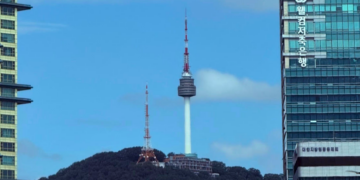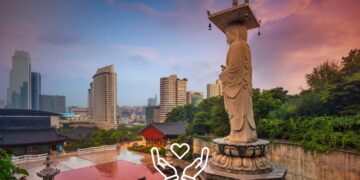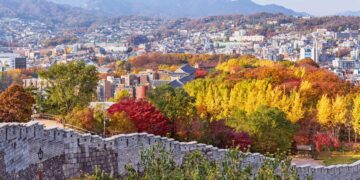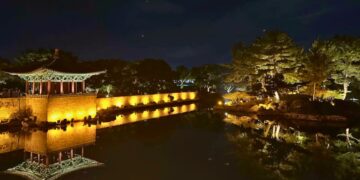Last Updated on 12 months by admin
The Seoul City Wall, also referred to as the Seoul Fortress Wall, is a stone, wood, and other materials-built wall that was built to defend Seoul against invasions. The city wall was erected in 1396 to defend and exhibit the city’s limits, which surrounded Hanyang during the Joseon Dynasty.
While most travelers may not seek out the Seoul Fortress Wall, they will come across it. While some people may neglect the wall itself, the gates that run along it are frequently on a trip. The wall is a great place to walk or hike when visiting Seoul. The paths are always clean, and there are never any problems getting lost. You’re also close to a subway station to get around easily. Don’t miss out on this spot!
History Of The Seoul City Wall
In 1395, just five years after the Joseon Dynasty was established, King Taejo set up a government office [Doseongchukjoedogam] to construct a castle in Seoul. Jeong Do-jeon was tasked with finding and quantifying a location.
Taejo of Joseon performed the cornerstone ceremony for Gyeongbok Palace on January 1, 1396 (by the lunar calendar). Over two years, 197,400 young men were conscripted and forced to work on the castle for 98 days after the war. There were eight gates on the wall, all of which were built between 1396 and 1398.
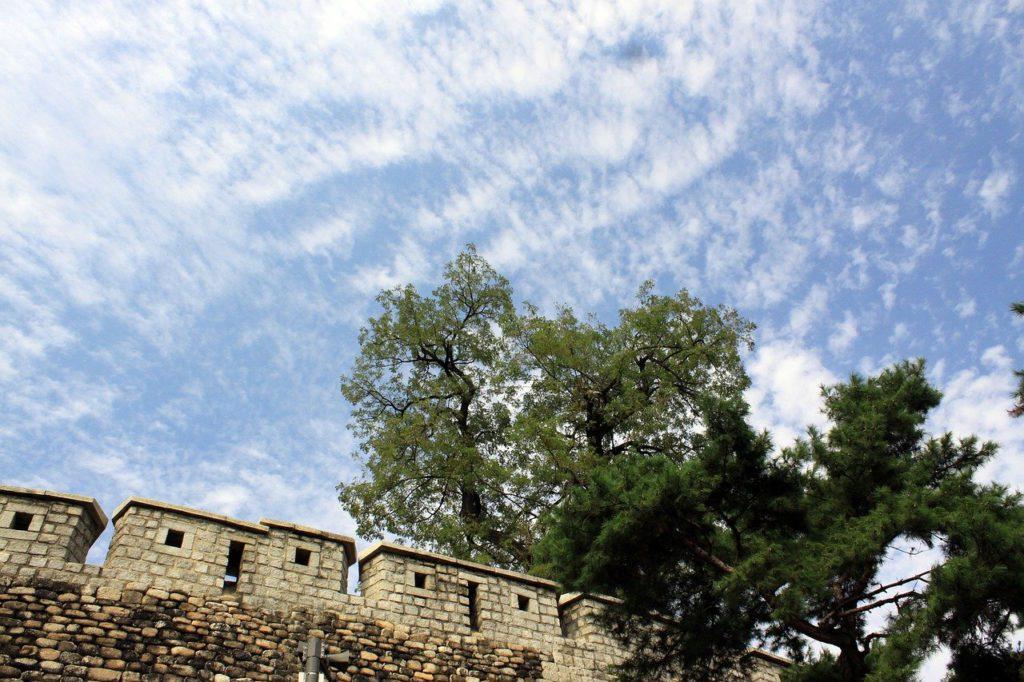
The ancient walls, made of medium-sized round stones held together by mud and erected in the late 14th century, were built. During King Sejong the Great’s reign in the mid-15th century, a massive restoration effort was carried out on the wall, with rectangular stone slabs replacing earthen wall elements throughout his reign in 1704.
Gates Of The Seoul City Wall
There are eight gates along the wall. Four of them (Heunginjimun, Donuimun, Sugyojongmun, and Gwanghwamun) were built in 1396 during the Joseon dynasty. The other four (Changuimun, Jongmyo Jongno, Hyehwamun, and Jogyeongmun) were added in later years.
Sungnyemun Gate (Namdaemun)
The Namdaemun Gate is the most significant, oldest, and well-known. For hundreds of years, it was the primary entrance into Seoul. It was erected in 1396. Now, it’s close to the Namdaemun market, which offers delicious seafood, shopping for lovely gifts, and a little daring by trying some pig’s feet.
During the day or at night, you may explore this gate and the marketplace. The gate illuminates the marketplace at night, making it seem even more gorgeous. On subway Line 4 (sky blue), Namdaemun is a short distance from Hoehyeon Station.
Heunginjimun Gate (Dongdaemun Gate)
For anyone attempting to tick as many items off their bucket list as possible, this is National Treasure No. 1. Like most of the others, this gate had to be rebuilt because it is the East Main Gate of the wall. It means “Rising Benevolence Gate.” In 1896, the Ongseong, the exterior wall that encircles it, was reconstructed, and what makes this gate so fascinating.
Around this gate, there is a lot to do. If you want to pamper yourself after a walk around, stop at the Belle Spa at Dongdaemun Hyundai City Outlet, which is by far the most popular activity in this area.
Sukjeongmun Gate
The northernmost gate is the only gate that still has both sides attached to the fortress wall. This gate is located on a mountain just behind Gyeongbokgung Palace and the Blue House. People need to have valid identification in order to view this gate.
The section of the wall where this gate is located was closed for 38 years after an assassination attempt on the president. It re-opened to the public in 2006. Please stay on the path and have a nice time since military personnel is still keeping watch. The guys who work on duty are usually courteous and helpful.
Souimun Gate
Seosomun gate was once the southwest auxiliary gate, demolished in 1914 during the Japanese colonial period. It was never restored because it means “Promotion of Justice Gate.” Where the gate once stood now, only a stone tablet remains. This gate, unlike the others, had never seen that day when it was restored to its former glory. The memorial serves as a stark illustration of how many conflicts this city has faced.
Donuimun Gate
The “Invisible Gate” is now called Donuimun Gate, which means “Loyalty Gate.” This was the West Main Gate at first; however, during the Japanese Occupation, it was replaced with a streetcar and sold off. Nevertheless, despite efforts to rebuild Donuimun Gate beginning in 2022, a public art installation named “Invisible Gate” has taken up the location where the gate once stood.
Changuimun Gate
Changuimun is located between the Inwangsan and Baegak Mountains, one of the smaller gates. This is the only auxiliary gate with the tower intact and is still standing today. Its name translates to “Showing The Correct Thing Gate.” Since a chicken is the nemesis of the centipede, and since it would keep the bad spirits of the centipede at bay, a wooden chicken sits in the rafters of this gate.
Hyehwamun Gate
This was one of the four auxiliary gates erected in the wall in 1396 under Dongbukmun, which means “Distribution of Wisdom Gate.” In 1511, it was renamed to what it is now. You may easily head up to the Ihwa Mural Village from this gate, located east of Changgyeonggung Palace and just north of Hyehwa.
Gwanghuimun Gate
This is one of the auxiliary gates located on the southeast side of the wall. It was rebuilt in 1711 after being destroyed during the Imjin War from 1592 to 1598, but it was damaged again during the Korean War and left in ruins for many years. Since funeral processions carrying corpses to the east passed through this gate, it was also known as Sigumun or the “corpse gate.” Because all corpses of the deceased, including kings and commoners, had to be buried outside of the wall, the wall that surrounded Seoul effectively became a dividing line between life and death.
The city’s past is alive and well in these gates of the Seoul City Wall, which have been through a lot over the years. Each gate has its own history and story.
Don’t forget to check out these other South Korea travel posts:
- Cat Lover Garden in Seoul – It’s More Than Just A Cat Cafe
- Top Things to Do In and Around Dosan Park: A Seoul Travel Guide
- Seoul Forest – All You Need To Know Before Your Visit
- All You Need To Know About Naksan Park
16,098 total views, 1 views today



